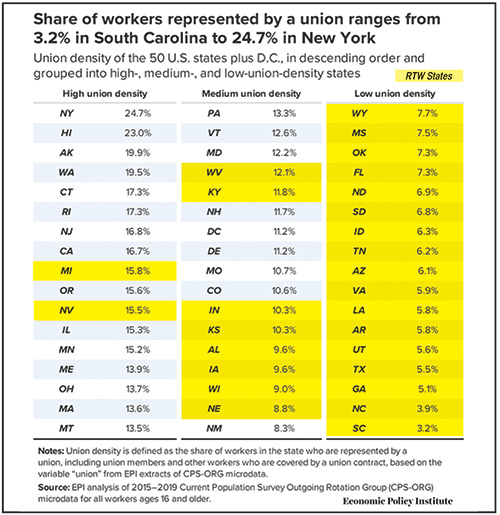
 In the same way unions give workers a voice at work – with a direct impact on wages and working conditions – unions also give workers a voice in shaping their communities.
In the same way unions give workers a voice at work – with a direct impact on wages and working conditions – unions also give workers a voice in shaping their communities.
A new report from the Economic Policy Institute (EPI) documents the correlation between higher levels of unionization and more equitable economic structures, social structures, and democracies.
The 17 U.S. states with the highest union density have state minimum wages that are on average 19 percent higher than the national average and 40 percent higher than those in low-union-density states. They also have median annual incomes $6,000 higher than the national average and have higher-than-average unemployment insurance recipiency rates, meaning a higher share of those who are unemployed actually receive unemployment insurance.
Illinois, with 15.3 percent union density, ranks 12th among states with the high union density.
Missouri, with 10.7 percent union density, ranks ninth among 17 states with only medium union density.
UNIONS BUILD WORKER POWER
“Unions promote economic equality and build worker power, helping workers to win increases in pay, better benefits, and safer working conditions. But the benefits of unions extend far beyond the workplace. The data suggest that unions also give workers a voice in shaping their communities and political representation,” says Asha Banerjee, economic analyst at EPI and co-author of the report.
The report finds that states with the highest union densities have an uninsured (without health insurance) population 4.5 percentage points lower, on average, than that of low-union-density states. These states also all elected to expand Medicaid under the Affordable Care Act and are more likely to have passed paid sick and family and medical leave laws than states with lower union densities.
According to the report, the 17 highest-union-density states (including Illinois) have passed significantly fewer restrictive voting laws than in the middle 17 states (including Missouri and the District of Columbia) and the 17 lowest-union-density states.
VOTING IMPACTED, TOO
“Through long-standing advocacy and work to protect the right to vote, unions have linked voting rights to workers’ rights,” says Margaret Poydock, policy analyst and government affairs specialist at EPI and co-author of the report. “Unions play a key role in mobilizing workers to vote, helping to determine which political leaders are elected and what occupational backgrounds they come from.”
The authors explain that the relationship between high union density and higher household incomes, access to health care and paid leave, and fewer voting restrictions highlights the importance of protecting the right of workers to organize, including passing the Protecting the Right to Organize (PRO) Act.
Community benefits of unionization
According to EPI economic analysts Asha Banerjee, Margaret Poydock, Celine McNicholas, Ihna Mangundayao and Ali Sait, the community and economic benefits of high union density stretch far beyond the immediate benefits to union members and their families.
INCOME AND ECONOMIC PROTECTIONS
The 17 U.S. states with the highest union density:
• Have state minimum wages that are on average 19% higher than the national average and 40% higher than those in low-union-density states.
• Have median annual incomes $6,000 higher than the national average.
• Have higher-than-average unemployment insurance recipiency rates (that is, a higher share of those who are unemployed actually receive unemployment insurance).
HEALTH AND WELL-BEING
States with higher union density:
• Have fewer uninsured – 4.5 percentage points lower, on average, than that of low-union-density states.
• Have all elected to expand Medicaid under the Affordable Care Act, protecting their residents from falling into the “coverage gap”.
• Are more likely to have passed paid sick leave laws and paid family and medical leave laws than states with lower union densities.
DEMOCRACY
When it comes to democratic principles and ease or difficulty of voting, the EPI report found the 17 states with the highest union density have:
• Significantly fewer restrictive voting laws than in the 17 medium union density states (including Missouri and the District of Columbia) and the 17 lowest union density states.
• Over 70 percent of low union density states passed at least one voter suppression law between 2011 and 2019.


